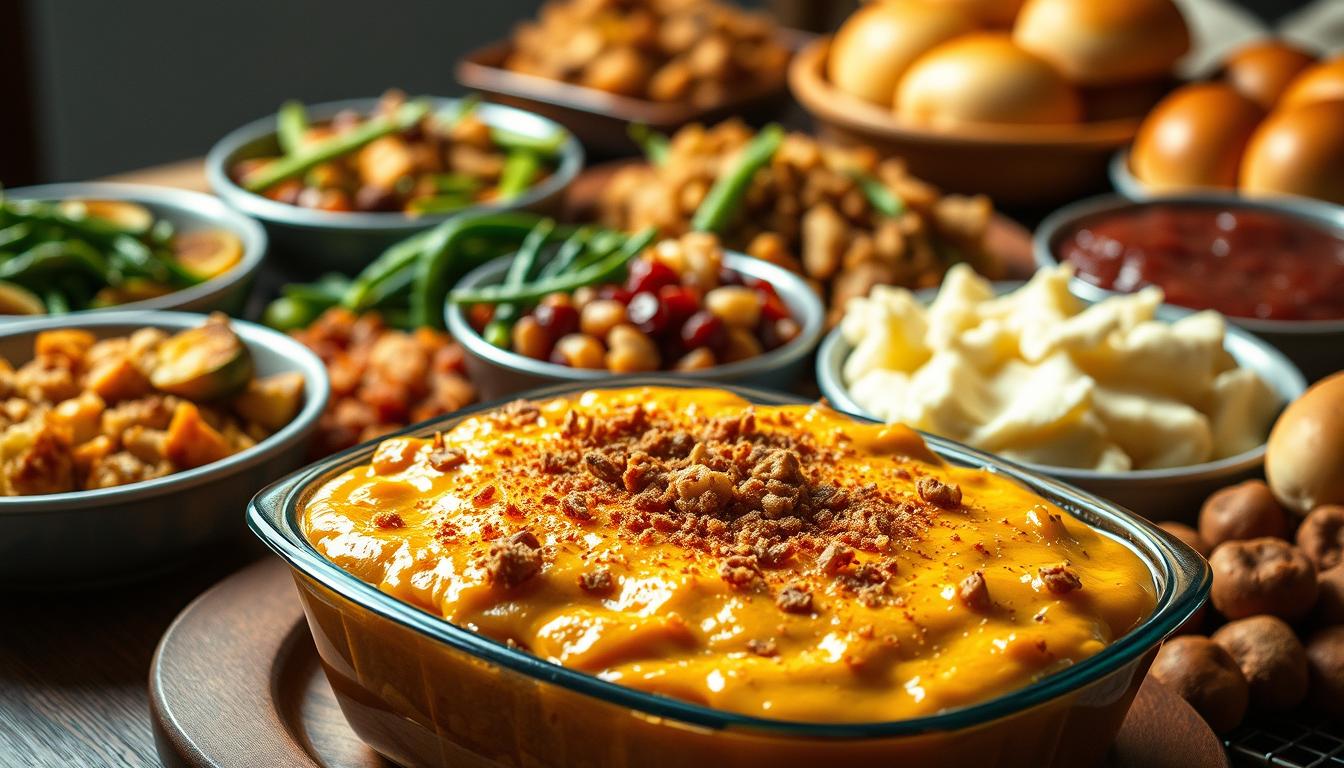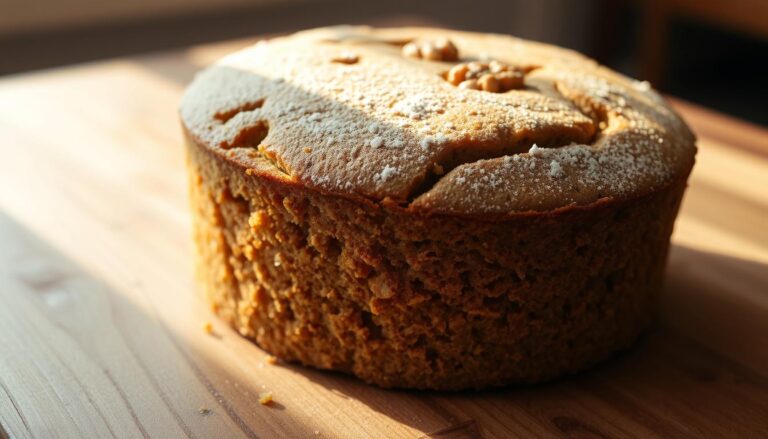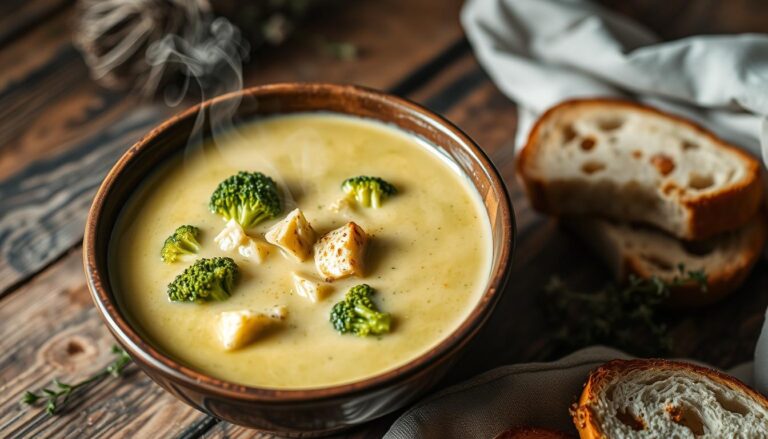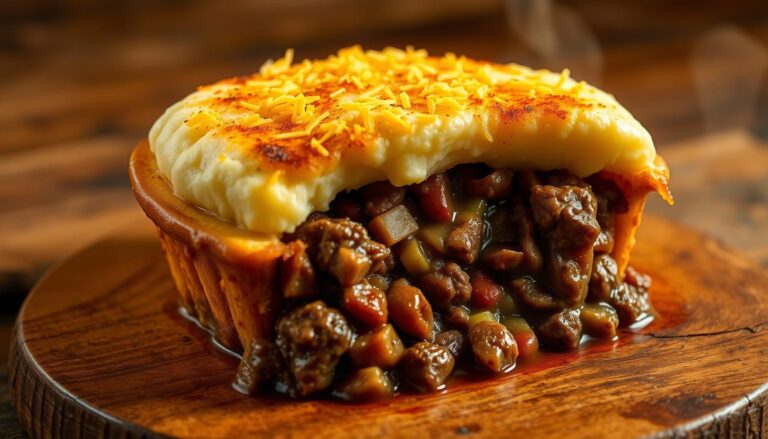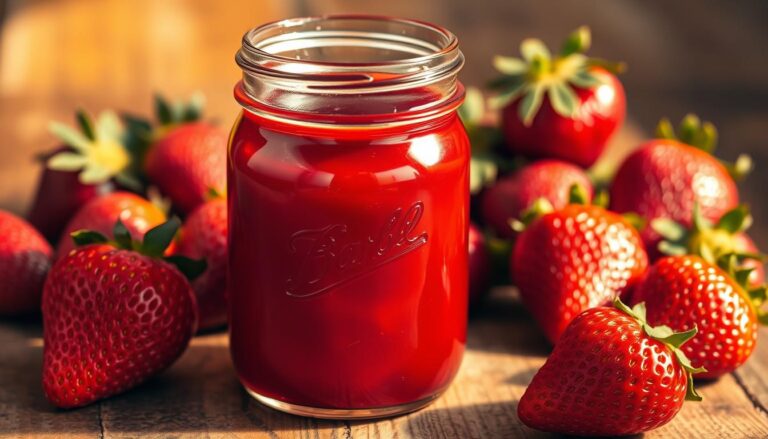Delicious Sweet Potato Casserole Recipe
A classic Thanksgiving side dish, the sweet potato casserole is a staple in many American households during the holiday season. This traditional holiday recipe is not only delicious but also easy to make, making it a perfect addition to your festive table.

The sweet potato casserole recipe is a crowd-pleaser, with its rich, comforting flavors and satisfying texture. It’s a dish that brings people together, evoking memories of warm gatherings and joyful celebrations.
Key Takeaways
- Easy to make and delicious
- A classic Thanksgiving side dish
- Rich, comforting flavors
- Perfect for holiday gatherings
- A traditional holiday recipe
The History and Tradition of Sweet Potato Casserole
The tradition of sweet potato casserole in American cuisine is a story of cultural fusion and culinary innovation. This beloved dish has its roots in the traditional cooking methods of early American settlers, who adapted their own recipes to incorporate the sweet potato, a staple ingredient in many Native American cuisines.
Origins of Sweet Potato Casserole in American Cuisine
Sweet potatoes were a mainstay in the Southern United States, where they were used in a variety of dishes, from savory meals to sweet desserts. The evolution of sweet potato casserole as we know it today involved the blending of African, European, and Native American culinary practices. African influences brought the use of sweet potatoes, while European traditions introduced the concept of casseroles. This fusion resulted in a unique dish that was both nourishing and flavorful.
Why It Became a Thanksgiving Staple
Sweet potato casserole became a staple at Thanksgiving gatherings due to its ease of preparation, nutritional value, and the availability of sweet potatoes during the fall season. As American cuisine evolved, this dish became a traditional holiday recipe, symbolizing warmth and hospitality. It’s often served alongside other classic dishes, making it a quintessential thanksgiving side dish. The combination of mashed sweet potatoes, sugar, and spices topped with marshmallows or a crunchy pecan streusel has made it a classic sweet potato casserole that many look forward to enjoying each year.
“The sweet potato casserole is more than just a side dish; it’s a connection to our heritage and a celebration of the harvest season.”
The table below highlights the key factors that contributed to sweet potato casserole becoming a beloved Thanksgiving tradition.
| Factor | Description | Impact |
|---|---|---|
| Cultural Fusion | Blending of African, European, and Native American cuisines | Unique flavor profiles and cooking techniques |
| Availability of Ingredients | Sweet potatoes were readily available during the fall season | Encouraged the use of sweet potatoes in seasonal dishes |
| Ease of Preparation | Simple to prepare and could be made in large quantities | Made it a practical choice for large gatherings |
Health Benefits of Sweet Potatoes
Sweet potatoes are a nutritional powerhouse, offering numerous health benefits that make them a great addition to a balanced diet. They are rich in essential nutrients, including vitamins, minerals, and antioxidants that promote overall health and well-being.
Nutritional Profile of Sweet Potatoes
Sweet potatoes are an excellent source of vitamins A and C, potassium, and fiber. According to the USDA, one medium-sized sweet potato provides more than 400% of the daily recommended intake of vitamin A, making it an excellent food for supporting healthy vision and immune function. The high fiber content in sweet potatoes also supports healthy digestion.
Why Sweet Potatoes Are Considered a Superfood
Sweet potatoes are considered a superfood due to their high antioxidant content and anti-inflammatory properties. As Dr. Michael Greger, a renowned nutrition expert, notes, “Sweet potatoes are a rich source of antioxidants, which can help protect against cell damage and reduce the risk of chronic diseases.” The antioxidants and anti-inflammatory compounds in sweet potatoes can help mitigate oxidative stress and inflammation, contributing to overall health.
Essential Ingredients for the Perfect Sweet Potato Casserole
Crafting the perfect sweet potato casserole begins with selecting the right ingredients. To make an easy sweet potato casserole or a more elaborate homemade sweet potato casserole, understanding the role of each component is crucial.
Selecting the Best Sweet Potatoes
The foundation of a great sweet potato casserole is, of course, the sweet potatoes. Look for sweet potatoes that are firm and have a vibrant orange color, indicating they are rich in beta-carotene. Avoid those with signs of decay or sprouting.
Key Ingredients for the Filling
Beyond sweet potatoes, the filling requires a mix of sugar, spices, and dairy products to achieve a rich, creamy texture. Using high-quality ingredients like real butter and pure vanilla extract can significantly enhance the flavor.
Topping Options: Marshmallows vs. Pecans
The topping is a crucial element, with marshmallow topping and pecan topping being the most popular choices. Marshmallows provide a sweet, fluffy contrast, while pecans add a crunchy, nutty flavor. The choice between them depends on personal preference or the desired texture.
| Topping | Description | Best For |
|---|---|---|
| Marshmallow | Sweet, fluffy texture | Those who prefer a classic, sweet contrast |
| Pecan | Crunchy, nutty flavor | Those who enjoy a textured, savory element |
Kitchen Tools and Equipment You’ll Need
To get started with your simple sweet potato casserole recipe, gather your essential baking tools and equipment. Having the right kitchen tools is crucial for a stress-free cooking experience.
Essential Baking Tools
You’ll need a few essential baking tools to make your sweet potato casserole. These include a large mixing bowl, a potato masher, a measuring cups and spoons, a whisk, and a 9×13 inch baking dish. A rubber spatula is also handy for scraping the sides of the bowl.
- Large mixing bowl
- Potato masher
- Measuring cups and spoons
- Whisk
- 9×13 inch baking dish
- Rubber spatula
Optional Equipment for Convenience
For added convenience, consider using optional equipment like an electric mixer to smooth out your sweet potato mixture or a food processor to chop nuts for the topping. A kitchen scale can also be useful for precise measurements.
- Electric mixer
- Food processor
- Kitchen scale
Preparing Your Sweet Potatoes: Boiling vs. Baking
Cooking sweet potatoes is the first step in making a delicious sweet potato casserole, and there are two popular methods to consider: boiling and baking. Both methods have their advantages, and the choice between them can affect the final flavor and texture of your casserole.
How to Boil Sweet Potatoes for Casserole
Boiling sweet potatoes is a quick and straightforward method. To boil sweet potatoes, start by washing and peeling them, then cut them into large chunks to ensure they cook evenly. Place the chunks in a large pot, cover them with cold water, and add a pinch of salt. Bring the water to a boil, then reduce the heat to a simmer. Cook until the sweet potatoes are tender when pierced with a fork, typically 15-20 minutes. Drain the sweet potatoes and let them cool before mashing.
How to Bake Sweet Potatoes for Enhanced Flavor
Baking sweet potatoes brings out their natural sweetness and adds depth to your casserole. To bake, preheat your oven to 400°F (200°C). Wash and dry the sweet potatoes, then poke some holes in them with a fork to allow steam to escape. Rub the sweet potatoes with a little oil and sprinkle with salt. Place them on a baking sheet and bake for 45-60 minutes, or until they’re soft when squeezed. Let them cool, then scoop out the flesh for mashing.
| Method | Cooking Time | Flavor Outcome |
|---|---|---|
| Boiling | 15-20 minutes | Neutral flavor, tender texture |
| Baking | 45-60 minutes | Enhanced natural sweetness, deeper flavor |
Both boiling and baking are effective methods for preparing sweet potatoes for your casserole. The choice between them depends on your preference for flavor and texture, as well as the time you have available.
The Ultimate Sweet Potato Casserole Recipe
Now that we’ve explored the history and benefits of sweet potatoes, it’s time to dive into the ultimate sweet potato casserole recipe. This beloved dish is a staple of American holidays, and with the right ingredients and techniques, you can elevate it to new heights.
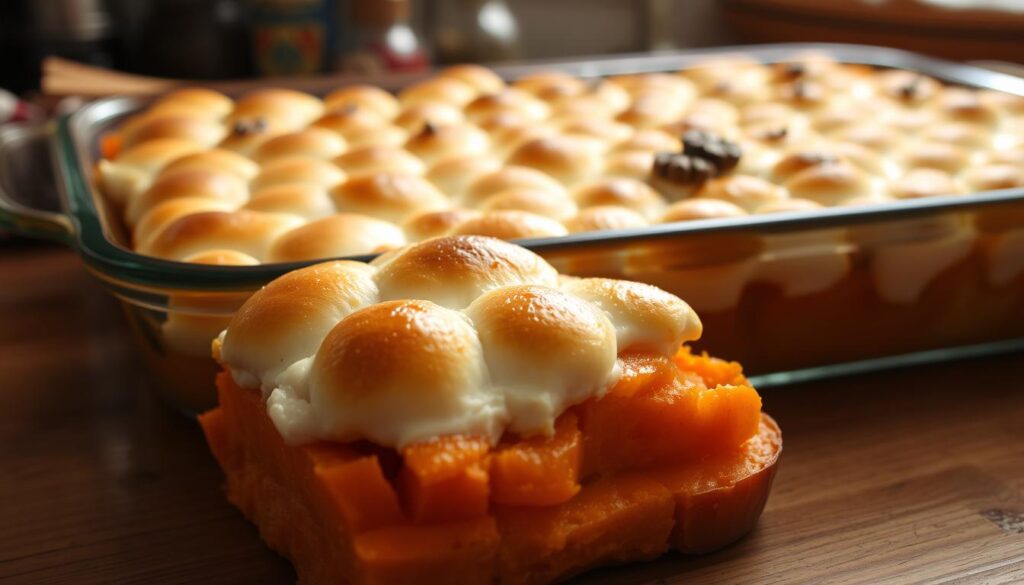
Preparing the Sweet Potato Base
The foundation of a great sweet potato casserole is, of course, the sweet potatoes themselves. To prepare the sweet potato base, start by boiling or baking 2-3 large sweet potatoes until they’re tender. Once cooled, mash them with a fork or potato masher until smooth. Add in 1/4 cup of granulated sugar, 1/2 teaspoon of salt, and 1/2 teaspoon of ground cinnamon to give the sweet potatoes a boost of flavor.
For an extra-rich casserole, you can also add in 1/4 cup of melted unsalted butter and 2 large eggs to the mashed sweet potatoes. Mix everything together until well combined, then set aside.
Creating the Perfect Sweetness and Texture
Achieving the perfect balance of sweetness and texture is crucial in a sweet potato casserole. To do this, you can adjust the amount of sugar to your taste, and consider adding other ingredients like marshmallows or pecans to the top of the casserole for added texture and flavor.
For a crunchy topping, mix together 1/2 cup of chopped pecans, 1/4 cup of granulated sugar, and 1/4 cup of all-purpose flour. Add in 1/2 teaspoon of ground cinnamon and 1/4 teaspoon of ground nutmeg to give the topping an extra boost of flavor.
Baking Instructions for Optimal Results
To bake the sweet potato casserole to perfection, preheat your oven to 350°F (175°C). Transfer the sweet potato mixture to a 9×13 inch baking dish and top with your chosen topping. Bake for 25-30 minutes, or until the topping is golden brown and the casserole is heated through.
For an extra-crispy topping, you can broil the casserole for an additional 2-3 minutes after baking. Keep a close eye on it to prevent burning.
Delicious Topping Variations
Elevate your sweet potato casserole with these delicious topping variations. The right topping can transform your dish, adding texture, flavor, and visual appeal. Whether you’re a traditionalist or an adventurer, there’s a topping to suit your taste.
Traditional Marshmallow Topping Recipe
A classic choice, the marshmallow topping adds a sweet and fluffy texture to your casserole. To make it, you’ll need mini marshmallows, butter, and a bit of brown sugar. Simply sprinkle the marshmallows over your casserole and dot with butter before baking until golden brown.
- 1 cup mini marshmallows
- 2 tablespoons unsalted butter, melted
- 1 tablespoon brown sugar
Crunchy Pecan Streusel Topping Recipe
For a crunchy contrast, try a pecan streusel topping. Mix chopped pecans, flour, brown sugar, and a pinch of salt with melted butter until crumbly. Sprinkle this mixture over your casserole before baking for a nutty, crunchy finish.
- 1/2 cup chopped pecans
- 1/4 cup all-purpose flour
- 1/4 cup brown sugar
- 1/4 teaspoon salt
- 1/4 cup unsalted butter, melted
Combining Both Toppings for the Ultimate Casserole
Why choose between marshmallows and pecans? Combining both toppings gives you the best of both worlds. Start with a layer of pecan streusel for crunch, then top with marshmallows for a fluffy finish. This combination is sure to impress your guests and satisfy both texture preferences.
Creative Flavor Variations for Your Sweet Potato Casserole Recipe
Transform your sweet potato casserole into a culinary masterpiece by incorporating unique and exciting flavor profiles. While the traditional recipe is always a crowd-pleaser, there’s room for innovation and personalization.
Savory Sweet Potato Casserole Options
For a departure from the sweet, try incorporating savory elements into your sweet potato casserole. Caramelized onions and a hint of rosemary can add depth and complexity. You can also experiment with different types of cheese, such as Parmesan or Gruyère, to create a richer flavor profile.
International Flavor Inspirations
Draw inspiration from international cuisines to give your sweet potato casserole a global twist. For example, incorporating Korean chili flakes (gochugaru) can add a spicy kick, while Middle Eastern sumac can provide a tangy, slightly sour flavor. These unique flavors can elevate your dish and offer a fascinating taste experience.
Seasonal Spice Combinations
Adjust your sweet potato casserole to the season by incorporating relevant spices and ingredients. During the fall, pumpkin pie spice or cinnamon can complement the sweet potatoes nicely. In the winter, a hint of nutmeg or allspice can add warmth. These seasonal adjustments keep your casserole fresh and exciting throughout the year.
Make-Ahead and Storage Tips
Planning ahead is key to stress-free holiday cooking, and sweet potato casserole is no exception. By preparing this dish in advance, you can enjoy your holiday celebrations without the last-minute rush.
How to Prepare Sweet Potato Casserole in Advance
To make sweet potato casserole ahead of time, prepare the sweet potato base and topping separately. Store them in airtight containers in the refrigerator for up to 2 days. On the day of serving, assemble the casserole and bake as directed. Alternatively, you can fully assemble the casserole, cover it tightly, and refrigerate it overnight before baking.
- Prepare sweet potato base up to 2 days in advance.
- Store topping ingredients separately.
- Assemble and bake on the day of serving.
Proper Storage and Reheating Methods
If you have leftovers or want to store the casserole for later, here are some tips:
- Cool the casserole completely before covering it with plastic wrap or aluminum foil.
- Refrigerate for up to 3-4 days or freeze for longer storage.
- Reheat in the oven at 350°F (175°C) until warmed through, or use the microwave for individual servings.
Dietary Adaptations: Making Your Casserole Inclusive
Making your sweet potato casserole inclusive is easier than you think, with a few simple adaptations. Whether you’re cooking for a crowd with diverse dietary needs or simply looking to mix things up, this section will guide you through the process of modifying your sweet potato casserole recipe to suit various dietary preferences.
Gluten-Free Sweet Potato Casserole Options
To make your sweet potato casserole gluten-free, focus on the ingredients that typically contain gluten, such as certain types of flour or additives in marshmallows or spices. Use gluten-free alternatives for these ingredients. For instance, you can replace traditional flour with a gluten-free flour blend in the streusel topping or use gluten-free marshmallows. Always check the labels to ensure that your ingredients are gluten-free.
- Use gluten-free flour for streusel toppings
- Choose gluten-free marshmallows or alternatives
- Be mindful of spice blends that may contain gluten
Vegan and Dairy-Free Adaptations
For a vegan or dairy-free sweet potato casserole, you’ll need to replace dairy products and potentially eggs. Non-dairy milk and vegan butter or margarine can be used in place of traditional dairy. To replace eggs, consider using flax or chia eggs, or commercial egg replacers. Marshmallows are often not vegan, so look for vegan marshmallow options or use alternative toppings like coconut whipped cream or a pecan streusel.
- Replace dairy milk with non-dairy milk
- Use vegan butter or margarine
- Choose vegan marshmallows or alternative toppings
Reducing Sugar Without Sacrificing Flavor
Reducing sugar in your sweet potato casserole can be achieved by using natural sweeteners like maple syrup or honey, and by leveraging the natural sweetness of sweet potatoes. You can also reduce the amount of sugar called for in the recipe or omit it altogether if using very sweet sweet potatoes. Another option is to use coconut sugar, which has a lower glycemic index than refined sugars.
Pairing Suggestions: What to Serve with Sweet Potato Casserole
When it comes to serving sweet potato casserole, the options are endless, from traditional holiday pairings to innovative wine pairings. This beloved dish is a staple of many gatherings, and its versatility makes it easy to pair with a variety of foods and beverages.
Traditional Holiday Pairings
Sweet potato casserole is a classic at many holiday gatherings, particularly during Thanksgiving. It pairs perfectly with traditional dishes like roasted turkey, green beans, and cranberry sauce. The sweetness of the casserole complements the savory flavors of these dishes, creating a well-balanced meal.
Wine and Beverage Pairings
For a more sophisticated dining experience, consider pairing your sweet potato casserole with a glass of wine. A Pinot Noir or a Merlot can complement the rich flavors of the casserole. Alternatively, a warm apple cider or a sparkling juice can provide a refreshing contrast to the warm, comforting casserole.
Balancing Your Meal with Complementary Dishes
To create a harmonious meal, balance the sweetness of the sweet potato casserole with savory or tangy dishes. Roasted vegetables, grilled meats, or a fresh salad can provide a nice contrast. For example, a salad with mixed greens, topped with a citrus vinaigrette, can cut through the richness of the casserole.
Troubleshooting Common Sweet Potato Casserole Problems
Troubleshooting is key to making a fantastic sweet potato casserole, and we’re here to guide you through the most common problems.
Making a delicious sweet potato casserole can be a challenge, but understanding how to address common issues can make all the difference. Here are some tips to help you overcome the most frequent problems.
Fixing a Runny Casserole
A runny sweet potato casserole can be disappointing. To avoid this, ensure you’re not overmixing the sweet potato base, as this can release excess moisture. Additionally, check that your casserole is baked long enough to allow the filling to set properly. If your casserole remains runny, try baking it for a few more minutes or adding a thickening agent like cornstarch or flour to the filling.
- Check the consistency of your sweet potato base before baking.
- Avoid overmixing the ingredients.
- Bake until the filling is set and the top is golden brown.
Preventing Burnt Toppings
Burnt toppings can ruin an otherwise perfect casserole. To prevent this, keep an eye on your casserole during the last 15-20 minutes of baking. If using marshmallows or a pecan streusel, consider covering the dish with foil to prevent over-browning. You can also try broiling the casserole for a shorter time to achieve a golden-brown top without burning.
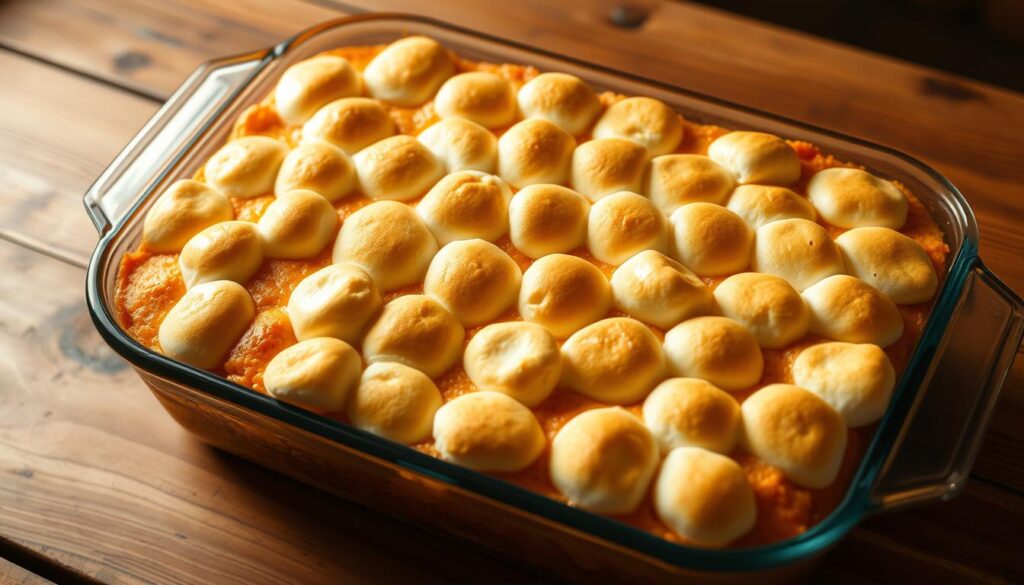
Adjusting Sweetness and Seasoning
Taste is subjective, and you may find your sweet potato casserole needs a bit more sweetness or a pinch of salt. To adjust, taste the sweet potato base before baking and add more sugar, spices, or salt as needed. Remember, you can always add more, but it’s harder to remove excess seasoning.
Tips for balancing flavors:
- Add a pinch of salt to balance sweetness.
- Use spices like cinnamon or nutmeg to add depth.
- Taste as you go to adjust seasoning.
Conclusion: Enjoying Your Homemade Sweet Potato Casserole
Now that you’ve mastered the art of making a delicious homemade sweet potato casserole, it’s time to enjoy the fruits of your labor. This classic sweet potato casserole is sure to become a staple at your holiday gatherings, bringing warmth and joy to those who taste it.
As you share your casserole with family and friends, remember that the true magic lies not just in the ingredients, but in the love and care you put into preparing it. Whether you’re using a traditional marshmallow topping or a crunchy pecan streusel, your homemade sweet potato casserole is sure to be a hit.
So go ahead, take a bite, and savor the flavors of the season. Enjoying your casserole is not just about satisfying your taste buds; it’s about creating memories that will last a lifetime. With this recipe, you’ll be well on your way to becoming the go-to chef for holiday meals, and your homemade sweet potato casserole will be the star of the show.
FAQ
What is the best type of sweet potato to use for sweet potato casserole?
For the best results, use orange-fleshed sweet potatoes, such as Beauregard or Jewel, as they are sweeter and have a softer texture when cooked.
Can I make sweet potato casserole ahead of time?
Yes, you can prepare the sweet potato casserole ahead of time. Assemble the casserole, cover it, and refrigerate for up to a day before baking. You can also bake it ahead and reheat it when needed.
How do I prevent the marshmallows on top of the casserole from burning?
To prevent the marshmallows from burning, cover the casserole with foil during the last 30 minutes of baking if using a marshmallow topping. Alternatively, you can broil the marshmallows for a short time to toast them lightly, watching closely to avoid burning.
Can I substitute marshmallows with a different topping?
Yes, you can substitute marshmallows with a pecan streusel topping or other nut toppings. Pecans add a nice crunch and flavor contrast to the soft sweet potatoes.
Is sweet potato casserole gluten-free?
The basic sweet potato casserole recipe is gluten-free. However, be sure to check the ingredients of any store-bought items, like marshmallows or spices, to ensure they are gluten-free.
How do I make a vegan version of sweet potato casserole?
To make a vegan version, replace eggs with a flax egg or applesauce, use a non-dairy milk, and choose vegan-friendly marshmallows or opt for a pecan topping. Ensure any other ingredients, like spices, are also vegan-friendly.
Can I freeze sweet potato casserole?
Yes, you can freeze sweet potato casserole. Prepare the casserole without the topping, let it cool, and then freeze. Thaw in the refrigerator and add the topping before baking or reheating.
What are some variations to the traditional sweet potato casserole recipe?
You can vary the traditional recipe by adding different spices, using various types of nuts or seeds for topping, incorporating citrus zest, or mixing in other ingredients like coconut flakes or dried cranberries to give it a unique twist.

